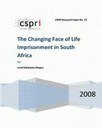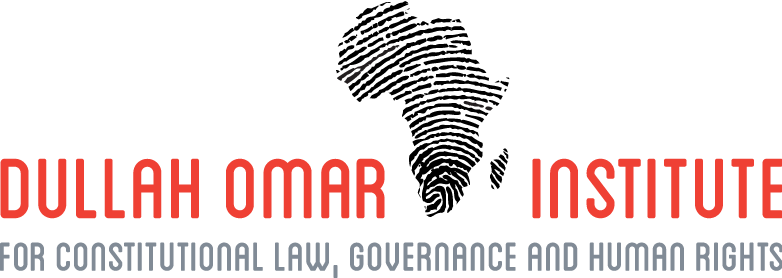by Vanja Karth, Jean Redpath & Michael O'Donovan. Report prepared for the Open Society Foundation for South Africa (OSF-SA).
ACJR Publications

This article investigates the meaning and use of life imprisonment in South Africa in four major legal historical eras: life imprisonment at the time when the death penalty was still lawful in South Africa (including life imprisonment as early as 1906); life imprisonment in the immediate aftermath of the abolition of the death penalty (1994-1998); life imprisonment following the introduction of the minimum sentences legislation (1998-2007); and life imprisonment after December 2007, when the sentencing jurisdiction of the regional courts was extended to include life imprisonment.

Every month in South Africa approximately 6000 sentenced prisoners are released, some on parole and some on expiry of sentence. After serving their prison sentences it is society’s expectation that they will refrain from committing crime and be productive citizens. They are expected to find employment, rebuild relationships with their families and communities, and cease from engaging in certain activities and avoiding the risks that caused their imprisonment in the first instance. Unfortunately, it is the case that many released prisoners commit further offences and find their way back to prison, some in a remarkably short period of time while others return after several years. This study is concerned with the immediate post-release period and asked a very simple question: “What happens to people immediately after they have been released from prison?” The question is aimed at gaining a deeper and empirical understanding of what prisoner re-entry and reintegration into society mean and what the obstacles are to successful reintegration. When people’s lives have effectively been put on hold for several months or years, how do they pick up the strings where they had left them, if there are indeed strings to pick up?

In 1998 South Africa ratified the UN Convention Against Torture, and Other Cruel, Inhuman or Degrading Treatment or Punishment (CAT) and in 2006 signed the Optional Protocol to CAT (OPCAT). By signing a convention a state expresses, in principle, its intention to become a party to the Convention or Protocol.


The incidence of HIV/AIDS infection in South African prisons has been extensively documented in recent years. This research has focused variously on the geographic and demographic spread of the disease and on the rights of inmates to prophylactics and to appropriate treatment and care. In contrast, little research has been directed towards the incidence and impact of the pandemic amongst correctional officials. From this research it is evident that whilst the Department of Correctional Services (DCS) has developed a fairly coherent (albeit unevenly implemented) programme for the prevention and treatment of HIV/AIDS amongst inmates, and notwithstanding the recent launch of a “Framework for the Implementation of a Comprehensive HIV and AIDS Programme” it has yet to develop and implement systematic measures to manage the disease amongst its own staff.
This submission discusses the South African Criminal Procedure Amendment Bill 42 of 2008, which aimed at allowing audio-visual link-up with the courts and at addressing the expungement of criminal records. The Criminal Procedure Amendment Act was adopted in 2008 (Act 65 of 2008).
The submission analyses statistics on deaths in custody and medical parole releases. An overview of legislative provisions is provided and recommendations are made in order to achieve greater consistency in decision-making.
"This publication aims to provide guidance on how the UN Convention against Torture and Cruel, Inhuman and Degrading Treatment or Punishment (CAT) can be used as a resource in South Africa to eradicate torture and ill-treatment...This prohibition of torture imposes on states obligations which are owed to all other members of the international community; each of these obligations has a correlative right. It signals to all states and to the people under their authority that 'the prohibition of torture is an absolute value from which nobody must deviate.' At the national level it de-legitimates any law, administrative or judicial act authorising torture."
This submission focuses on the prevention and combating of torture, cruel, inhuman or degrading treatment within the context of the Prevention of and Treatment for Substance Abuse Bill [B12- 2008]. The overall objective is to promote the use of two international instruments (UNCAT and OPCAT) and, more specifically, to assist in creating the enabling legislation to give effect to section 12 of the Constitution.
This submission is made to the South African Portfolio Committee on Justice and Constitutional Development and addresses the Criminal Law (Sentencing) Amendment Bill [B15 of 2007]
This submission was made in response to South Africa's Department of Correctional Services tabling of its 2008/09 budget. It addressed the size of the prison population, the seven-day establishment, the PPPs, and the implementation of the White Paper on Corrections.

Prisons serve a set of complex, mutually conflicting and hard-to-achieve goals. Prisons must house people in a humane manner but simultaneously appeal to the punitive nature of prisons — order and security must be maintained while providing an effective deterrent, and appease political opinion. It is in this “inherent policy vagueness” that stakeholders (for example, politicians, bureaucrats and civil society) must find a compromise (Boin, James and Lodge, 2005: 7). Can a constitutional democracy, such as South Africa, find an acceptable compromise, and what would “acceptable” mean under the rules of a constitutional democracy? This report investigate these questions and looks at what are the constitutional requirements for prisons as well as the threats and stumbling blocks en route to meeting these.

The Judicial Commission of Inquiry into Allegations of Corruption, Maladministration and Violence in the Department of Correctional Services – The Jali Commission - wrote a comprehensive report that investigated various areas of the Department of Correctional Services (DCS). The Jali Commission established that the DCS had various problems that made it function in a manner that left a lot to be desired. The Jali Commission made various recommendations (114+) in its 1800+ page report. The CSPRI summarised the Jali Commission report and put in a user-friendly language for most of us who do not have time to read and comprehend the whole report and also for ease of reference.
The submission focuses on deaths and assaults in prisons and calls for the criminalisation of torture.
